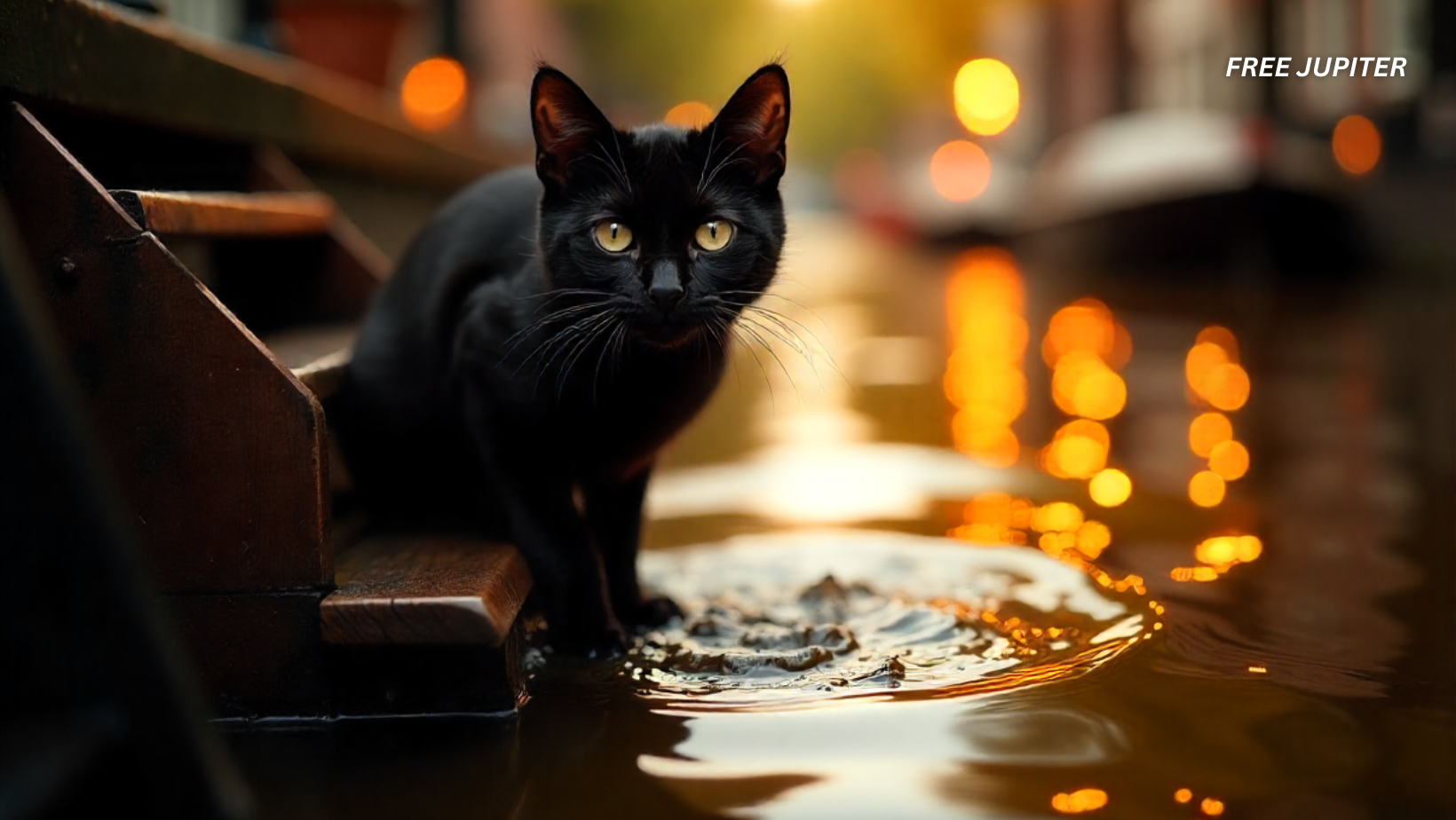Friendly Note: FreeJupiter.com shares general info for curious minds 🌟 Please fact-check all claims—and always check health matters with a professional 💙
Amsterdam is known for many things—windmills, cheese markets, bicycles, tulips, and, of course, its postcard-perfect canals. These waterways, carved into the heart of the city centuries ago, are so special that they’re listed as a UNESCO World Heritage Site. They’ve witnessed the rise of the Dutch Golden Age, the passage of historic trading ships, and countless boat tours carrying wide-eyed visitors.
But amid this beauty, there’s an unexpected hazard—one that’s been quietly claiming lives. It doesn’t target tourists or boat operators, but rather some of Amsterdam’s most adored residents: its cats.
The Unseen Danger Beneath the Surface
Cats have a special place in Amsterdam’s heart. They wander freely along narrow cobblestone streets, keep watch from shop windows, and even live aboard houseboats moored along the canals. Their independence is part of their charm, but it can also get them into trouble.
In the past six months alone, 19 cats have drowned after accidentally falling into the city’s canals. While cats can swim, they’re not built for prolonged water survival. The smooth, vertical edges of canal walls mean there’s nowhere to climb out, and panic or exhaustion often takes over before they can find safety.
Stray cats are particularly vulnerable. Without owners to notice they’re missing right away, their absence might go unremarked until it’s too late. For a country that deeply values animal welfare, these incidents have become too frequent to ignore.
Read more: New Study Shows Elephants Have Been Attempting to Communicate With Us For Years
A Simple but Clever Solution
Determined to stop more tragedies, Amsterdam is investing €100,000 into building small wooden staircases along its canals. The idea is charmingly straightforward—create escape routes so that if a cat, or any other small creature, ends up in the water, they can find a way out.
The staircases will be installed at strategic points, chosen based on where most accidents have been reported. Dierenambulance Amsterdam, an animal rescue and welfare group, is partnering with the city to gather this data. Their rescue teams have firsthand knowledge of the most dangerous spots, making them ideal partners for the project.
The funding comes from an unused biodiversity budget—money originally set aside to protect the variety of life within the city. While some might question whether this qualifies as biodiversity spending, the city sees it as part of a broader mission: making urban spaces safer for all living creatures, whether they’re wild, stray, or beloved pets.
From Cat Traps to Catwalks
In Dutch, the staircases have been nicknamed kattentrappen, which translates to “cat traps.” The term is misleading—they’re meant to save lives, not ensnare them. English speakers might be tempted to call them “catwalks,” which would be far more fitting, especially in a fashionable European city. But regardless of the name, their purpose is clear: offering a lifeline to animals in distress.
A Growing Trend in Dutch Cities
Amsterdam isn’t the only city thinking about feline safety. Amersfoort, about 50 kilometers away, has already installed roughly 300 cat staircases as part of its 2024 animal welfare plan. Local residents even helped pinpoint where to put them, creating a community-driven safety net for their city’s cats.
The Amersfoort initiative is a glimpse of what could become a nationwide movement. If successful, these measures might inspire other canal cities in the Netherlands—and beyond—to take similar action.
Why Canals Are Dangerous for Animals
While canals are picturesque, they’re not friendly to wildlife. The steep banks, fluctuating water levels, and sometimes fast-moving currents create obstacles for animals that end up in the water. Even strong swimmers can find themselves trapped, with no natural ledges or vegetation to help them climb out.
Cats aren’t the only ones at risk. Ducks, hedgehogs, small dogs, and even rodents can face similar dangers. By building these staircases, Amsterdam is creating a simple, low-cost solution that benefits multiple species at once.
Read more: Study Finds Female Frogs Literally Pretend to Be Dead to Avoid Mating With Males They Don’t Like
The Bigger Picture: Cities Making Room for Wildlife
Amsterdam’s cat staircases are more than a charming local project—they’re part of a global rethink about how cities interact with nature. Urban environments have traditionally been built with human convenience at the center, often forgetting that cities are shared with countless other species. But in recent years, planners, conservationists, and everyday citizens have been coming together to redesign these spaces so that animals can live alongside people safely.
The results are as creative as they are practical:
- London, UK – Hedgehog Highways
In suburban areas of London, hedgehogs—those small, spiny nocturnal wanderers—were facing a crisis. Modern garden fences and walled yards were turning neighborhoods into mazes they couldn’t navigate, cutting them off from food, mates, and shelter. To solve this, “hedgehog highways” were born: small holes cut into the bottoms of fences so hedgehogs can pass freely between gardens. It’s such a simple idea that it’s now being promoted nationwide, with homeowners proudly labeling their fence holes as official wildlife corridors. - Paris, France – Bee-Friendly Rooftops
In Paris, rooftops are getting a green makeover. Many flat roofs are being transformed into miniature gardens filled with flowering plants that attract bees and other pollinators. This isn’t just a kindness to the bees—it’s an ecological necessity. Pollinators are critical for plant reproduction, and urban green roofs help sustain their numbers in a concrete-heavy city. These rooftop oases also help regulate building temperatures, improve air quality, and create pockets of biodiversity high above busy streets. - Brisbane, Australia – Rope Bridges for Possums and Gliders
In Brisbane and other parts of Queensland, tiny marsupials like sugar gliders and possums often risk their lives crossing roads and highways in search of food or nesting sites. To keep them safe, rope bridges and canopy crossings are strung high above traffic, connecting treetops on either side. From the ground, they look like whimsical garden hammocks in the sky, but for these animals, they’re lifelines that prevent deadly encounters with cars. - Spain – Bat Bridges Over Motorways
In parts of Spain, conservationists have turned their attention to bats, which play a huge role in controlling insect populations. The rapid expansion of roads was cutting off bat flight paths, leading to collisions with vehicles and loss of foraging grounds. Special “bat bridges”—structures that guide bats over busy highways—have been constructed to keep their natural routes intact. These bridges often use tall poles or wires that mimic the natural landscape, encouraging bats to fly higher and avoid danger.
A Shift in Urban Thinking
What ties all these ideas together is a growing awareness that human spaces don’t have to be barriers. Small changes in design can open entire worlds for wildlife—holes in fences, platforms above canals, gardens on rooftops, and bridges in the sky.
These adjustments aren’t just about compassion; they’re also about balance. Cities rely on healthy ecosystems more than many people realize. Pollinators like bees keep food systems running, hedgehogs eat garden pests, and bats control mosquito populations. Helping them survive helps us, too.
And perhaps the most important lesson is this: you don’t always need grand, expensive projects to make a difference. Sometimes, saving a life is as simple as a wooden staircase, a gap in a fence, or a line of rope stretching between two trees.
Read more: Chernobyl’s Radioactive Zone Is Creating a New Kind of Dog
A Kindness That Ripples Outward
Maarten Krom of Dierenambulance Amsterdam calls the staircases “a simple measure” with the potential to “prevent enormous animal suffering.” And that’s the beauty of it—saving lives doesn’t always require high-tech gadgets or complicated engineering. Sometimes, it just takes a bit of wood, a dash of thoughtfulness, and a willingness to act.
In an age where cities are often criticized for being cold, concrete jungles, Amsterdam’s approach feels refreshingly humane. It’s a reminder that infrastructure can be designed not just for efficiency and function, but also for compassion.
For the cats of Amsterdam, these staircases might be the difference between tragedy and another leisurely afternoon spent basking in a sunny café window. And for everyone else, they’re proof that kindness, even in small doses, can be quietly revolutionary.










